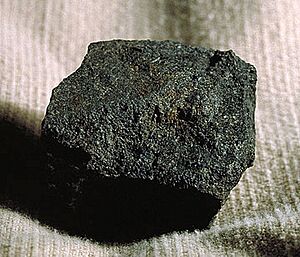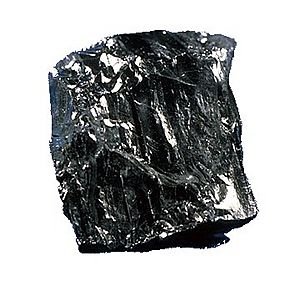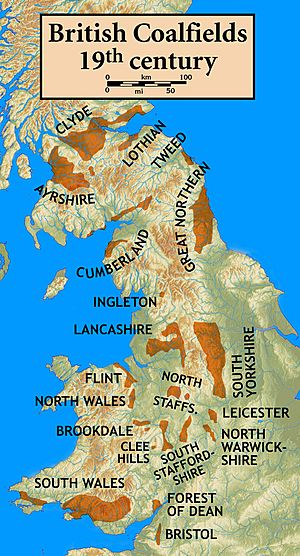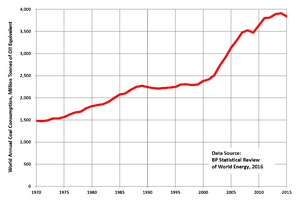Coal facts for kids
Coal is a hard rock that we can burn for energy. It's a type of fossil fuel, which means it formed from ancient plants. Coal is mostly made of carbon, but it also has small amounts of hydrogen, sulphur, oxygen, and nitrogen. It's a sedimentary rock, which means it formed over millions of years from layers of peat (partially decayed plant matter) that were pressed down by other rocks.
Coal comes from plants that lived millions of years ago in warm, wet areas, like the coal swamps of the Carboniferous period. When these plants died, they sank into the swampy water. Over time, layers of mud and other plants covered them. The heat and pressure from these layers slowly turned the plant material into peat, and then into coal.
We use coal mainly for energy and heat. About two-thirds of the coal dug up today is burned in power stations to make electricity. However, burning coal releases a lot of carbon dioxide into the air. This gas is a big cause of climate change. Because of this and other air pollution from coal, many countries are now using more solar power and other clean energy sources. Still, some new coal power plants are being built in places like China.
Coal can also be heated in a special way (without air) to make coke. Coke is used in factories to help turn metal ores into useful metals like iron.
Contents
History of Coal Use
Coal was super important during the Industrial Revolution. This was a time when new machines and factories changed how people lived and worked. Coal powered steam engines, trains, and factories. In the 20th century, coal was a major cargo carried by trains in the UK. But in the early 21st century, many coal power stations in the United Kingdom and other countries were closed. This was done to reduce greenhouse gases that cause climate change.
Types of Coal and How They Form
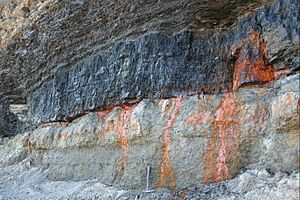
As plant material changes into coal over millions of years, it goes through several stages:
- Peat is the first step. It's not quite coal yet, but it's made of partially decayed plants.
- Lignite (also called brown coal) is the lowest quality coal. It's about 60-70% carbon. It's mostly used to make electricity. A special type of lignite called jet can be polished and used as a gem.
- Sub-bituminous coal is used for making electricity. It's also a source of chemicals for industry.
- Bituminous coal is a dense, black rock. It's a softer coal that burns easily. It's used in power stations, for heating, and to make coke.
- Steam coal used to be a common fuel for steam locomotives (old trains).
- Anthracite is a harder, shiny black coal. It burns for a long time and is mainly used for heating homes and businesses.
- Graphite is very hard to burn, so it's not often used as fuel. It's used in pencils (mixed with clay) and as a lubricant (something that makes things slide smoothly).
It's a common mistake to think that Diamonds come from coal. While both are made of carbon, diamonds form deep within the Earth under extreme pressure and heat, not from coal.
Coal can have impurities, which are unwanted substances. For example, coal used to make coke needs to have very little ash, sulfur, or phosphorus. These impurities would harm the iron made in a blast furnace.
Environmental Concerns with Coal
When coal is burned, it releases a lot of carbon dioxide. This is almost a third more than oil and 80% more than natural gas for the same amount of energy. Nearly half of all carbon dioxide from human activities comes from burning coal, making it the biggest cause of global warming.
Burning coal also causes acid rain and smog, especially if special filters called scrubbers aren't used. It releases harmful chemicals like soot, mercury, and carbon monoxide. These can cause diseases like cancer and asthma in people and harm wild animals.
Coal mining, especially a method called mountaintop removal, can damage large areas of land and destroy natural habitats for animals. Even though higher grades of coal burn a bit cleaner, they still pollute more than other fuels.
Besides air pollution, burning coal creates toxic ash. If this ash gets into the environment, it can cause water pollution. There are also underground coal fires burning in some parts of the world. These fires release toxic smoke and can make the ground above them collapse. For example, the town of Centralia, Pennsylvania, had to be evacuated because of an underground coal mine fire.
Health Problems from Coal Pollution
It's hard to know the exact numbers, but it's believed that over 800,000 people die early each year because of coal pollution, and millions more get sick. Coal miners often get a lung disease called pneumoconiosis (or black lung disease) from breathing in coal dust.
Protests Against Coal
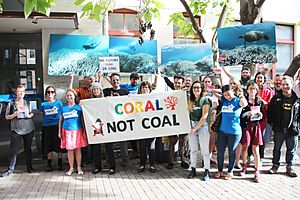
People have been protesting against coal pollution for a long time. These protests were a big reason why the modern environmental movement started in the 1800s. People continue to protest today, often to protect natural places or to fight against climate change.
Peak Coal
"Peak coal" is the year when the most coal is mined or burned. Many countries have already passed their peak coal years, meaning they are now using less coal. For example, Germany's peak was in 1985, and the United States' was in 2008. However, China still mines a lot of coal and helps other countries, like Pakistan, build more coal power plants. So, it's possible that the world's peak coal year has already passed, but it's not certain.
Coal's Role in Energy
Compared to other energy sources, coal is not very efficient and creates a lot of greenhouse gases. However, it is found in many places and is often cheap to get.
- Coal provides about a quarter (25%) of the world's heating needs.
- Electricity: Coal-fired power stations produce 37% of the world's electricity.
- Industry: Almost 70% of the world's steel production relies on burning coal.
Countries and Coal
The country that produces the most coal is China, digging up about 4 billion tonnes each year. After China come India, the United States, Australia, Indonesia, and Russia, each producing less than a billion tonnes. Australia is the biggest exporter (seller) of coal to other countries. The biggest importers (buyers) are China, India, and Japan.
Coal in Stories
In some cultures, Santa Claus is said to bring coal to children who have been naughty for Christmas. This old story comes from Victorian times, when many homes used coal in their fireplaces. The idea was that if children didn't get toys, they would at least get coal to stay warm.
Related pages
Images for kids
-
Coal ranking system used by the United States Geological Survey
-
Coke ovens at a plant in Wales, United Kingdom
-
A Bulldozer pushing coal at a power station in Slovenia
-
Large coal docks in Toledo, Ohio, 1895
See also
 In Spanish: Carbón para niños
In Spanish: Carbón para niños


